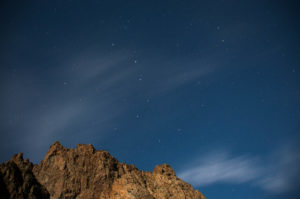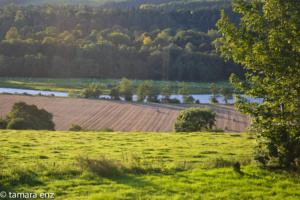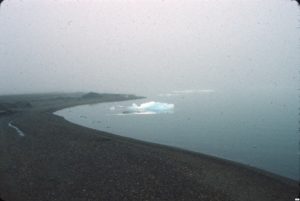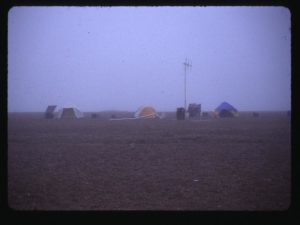Thar there be bears
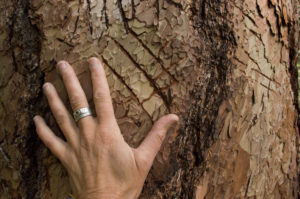
Tempeh Sausages with Pepper Spray on the Side
A few weeks ago in a random historic-site parking lot in far-flung western Colorado I met a 60-something woman from Atlanta. “You’re traveling alone? Well good for you. I always wanted to do that but I just don’t have the courage. Some day I will. You’ve never had any problems?”
This is a common question when people see me alone. A few variables in wording, some more direct language about scary people and places to avoid, but the sentiment is the same.
I’ve worked alone in many remote places over the years. I have occasionally stepped out of sight when I felt unsure about what was coming my way. I’m more often worried about destroying an axle, not finding my way out of a random maze of canyons, or falling off a cliff than about other people.
A few years ago while traveling in Scotland with an old friend, we were ready to stop for the night; we needed food, Scotch whisky, and a place to stay. We found a pub with a few rooms for let on the second floor but they were already full for the night.
Explaining that we would like to have dinner and a wee dram or two of whisky, we asked for a recommendation on a B&B within walking distance. Oh, well, sit, eat, we’ll call around and see what we can find.
We sat, we drank, we ate.
“So, I found a place for you to stay,” the owner, a rather burly Scotsman, told us. “At ten o’clock I’ll take you out back to the walking bridge over the river. You can take your bags across with you; a man will meet you on the other side with his car, and take you to his B&B for the night.”
My friend and I looked at each other. In the US, this is a set up for an Alfred Hitchcock movie.
He continued, “There’s only one problem.”
We looked at each other again, clearly thinking the same thing: there’s only one problem with a man transferring two American women across a Scottish river to another unknown man in the middle of the night?
“The breakfast is vegetarian.”
Of course, we should have thought of that. A vegetarian breakfast could be a problem; those tempeh sausages just don’t set well with many.
Bad things can happen to men and women. Sometimes they happen in remote places, sometimes not, occasionally to people traveling alone, sometimes not. Obviously, some places are inherently more dangerous, more restrictive, or more stressful. Being open to situations as they unfold and using common sense go a long way toward staying safe.
Every culture, every country, has its idea of what is safe and what is acceptable for women to do. Pushing the envelope with vegetarian sausage is not exactly ground breaking. But being able to travel freely, especially in your own country and specifically in one that prides itself on individual freedom, must not be a privilege.
I am not completely foolhardy. I carry bear spray, not mace but real bear spray, as in, for grizzly bears. I keep it in the truck and take it into the tent/camper with me each night.
Last summer while camping alone in Oklahoma I had the sudden thought that I should check the new canister. It was already late and dark and I was cozy in my tent but had some odd feeling that made me want to be sure it was good to go. Apparently, it was more than good to go. Before I fully removed the glow-in-the-dark safety clip the canister discharged, just a small blast, in the tent.
The tent is pretty roomy for one person – it is, after all, a 2-3-person tent. But no tent of any size is sufficient to escape bear spray. I closed my eyes and gulped spray-free air as soon as I heard the spray escape. Unzipping the tent and staggering outside I could feel the pepper burning into my nose and eyes. Cursing, and laughing at my own stupidity (once again!), with my eyes still shut I wandered the 50 meters to the truck, found the spare key, unlocked the door, found the water containers, and tipping my head sideways, poured two gallons of water across my face.
Eventually I was able to breath freely again and my eyes stopped burning and watering but the tent took much longer to air (think: weeks) and every time I turned in my sleeping bag a little puff of pepper spray would hit me. There is still a cayenne-red stain on the tent wall.
Now, when I am asked about camping alone I think of this incident. The fears we may have about stepping into the world like this are mostly unfounded. And, I am here to tell you: we are mostly our own worst enemies.
The usefulness of nothing
We put thirty spokes together and call it a wheel;
But it is on the space where there is nothing that the usefulness of the wheel depends.
We turn clay to make a vessel;
But it is on the space where there is nothing that the usefulness of the vessel depends.
We pierce doors and windows to make a house;
And it is on these spaces where there is nothing that the usefulness of the house depends.
Therefore just as we take advantage of what is, we should recognize the usefulness of what is not. Dao de jing
29 July 2000, Cooper Island, Alaska
I’ve been walking since I got up this morning, and eating, of course. The wind and rain of the other day finally passed. Yesterday was foggy and freezing; everything was covered with a thin sheet of ice. The fog lifted briefly in the afternoon and it was warm. This morning when I awoke the air was absolutely dead calm, the fog as thick as it has ever been. And so, I walked.
There is silence and stillness to this fog world that is unmatched. Even intensely cold days in the north woods have sound and a feeling of motion: the creak of ice laden branches as they sway under their burdens, the crunch of sub-zero-temperature snow underfoot. This Arctic fog stillness is absolute.
To stand on the edge of the water and look into the gray void created by the sky and water uniting in color and texture is to truly experience sensory deprivation. Except for a few birds, my footsteps, and the almost imperceptible wash of water on the shore there is no sound, even these few things you must work to hear. All sense of sight is gone; the utterly calm water perfectly mirrors the sky, eliminating any evidence of a boundary between them. Without an automatic brain override of the fog, I would think I was losing my sight.
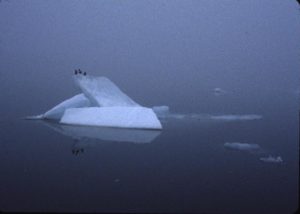
Black guillemots on ice floe
Now and then, on the lagoon side of the island, a dark spot that is a loon or a long-tailed duck will break free of the fog and show itself, giving definitive life to the water and proving that there is more than one dimension. On the ocean side, ice floes loom, moving imperceptibly; they often calve. The sound, that distorted fog sound, travels across the water. In the ocean there is no change, no motion, and no acknowledgement by the water or the air that the ice balance has shifted. Only silence once again.
Occasionally a red-throated loon gives its eerie, raspy, almost desperate call. No loon is in sight but I know it is among the ice floes, bill pointed to the foggy sky, head cocked to one side, listening into the silence for an answer. Listening for any sound at all, some proof that the rest of the world still exists. Is it only in our imagination that there was once wind and motion, sounds of water washing against the shore, or the persistent calls of numerous other birds?
I attempted many photos of this deprivation, some hard fast object in the foreground with the limitless depths of fog-gray-void behind. How does one record the lack of something to see? I’m not sure. If there is anything in these photos, any depth or contrast, any color, any motion, they will be stupendous indeed. In many ways this is the essence of my purpose here, to record that which is not plainly visible, to show that despite this seeming void, life thrives just out of view, and that there is usefulness in that which we cannot see and do not know.
Words of warning
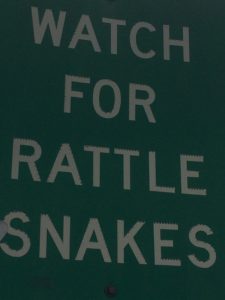
Watch for rattlesnakes
Possible headline: Dumb biologist struck by rattlesnake
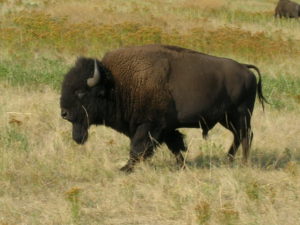
Part 1. People are stupid
Recently I saw a video of a woman and a bison. The bison was lying next to a walkway in Yellowstone National Park. The woman stopped to pet it on the head as casually as if she was petting a favorite horse. As if brushing off a fly, the bison tossed its head at her. She stepped back and made a face, as if scolding it, then reached out and touched it again. Again the bison tossed its head. Amazingly, the woman walked away without being gored, trampled, or obliterated by the 1000-pound wild bison.
Part 2. People are stupid
Driving down a narrow canyon somewhere I can’t now remember in Colorado I came upon a bighorn ram with a beautiful full curl. It was late November, the end of the rut. The ram was standing on the double yellow line, broadside to traffic, with no apparent interest in anything but the slope in front of him. At the time, I still had my Tercel, a car seemingly half the size of the ram. I had never seen a bighorn sheep before; I shut off the engine and watched.
After several minutes, a brand-new, bright red, dual rear-wheel, Dodge Ram 2500 diesel came up the canyon. The ram did not move. The truck sat a minute and then slowly rolled forward. The ram held his ground. The truck moved another few feet forward.
The ram politely stepped back one step, and then one more. The truck began to inch ahead. The ram took another step back, lowered his head, and let loose with all of the power of the rut directly into the front quarter panel of the shiny truck.
I laughed, of course. The expression of the man driving the truck was beyond description.
The ram, head held high, stepped back; clearly, he won this round. Another step back. The truck driver writhed in his seat, livid. It seemed his instinct was to immediately get out to check damage. Instead, he decided to move ahead. Was it an attempt to flee to safety? The ram stepped back again, lowered his head, and connected with a new spot on the front quarter panel.
Concealed weapons permits were not big then and I wasn’t yet fully aware of how many people carried weapons in their rigs. I writhed in my seat, in mirth. What more could a girl new to the west ask for than a show like this?
I don’t remember what broke the stand off. The ram finally turned into the canyon below the road and the truck continued up the canyon.
Part 3. Sadly, I count as people
A few years later I was working on the National Bison Range in Montana. I spent my days hiking everywhere, mapping plant communities, taking photos, enjoying the wildlife.
Early one morning, while the world was still cool and snakes were not warmed up, I found a den. I was standing on a slope deciding whether to go up or down. I turned up, picked up my foot, heard a rattle and just continued spinning back down to the point where I began. I turned to look. Two large snakes, two to three feet long, were coiled side by side. Next to them was a ball of snake babies. The babies were a wriggling mass. As I watched, one of the larger snakes disappeared into a hole under a rock. The babies, one by one, extracted themselves from the ball and followed – nine in all, each about 10 inches long. As the last baby went into the hole, the second larger snake followed.
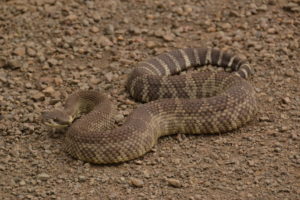
Rattlesnakes are fascinating and fabulous. They are also much maligned and persecuted creatures. People go out of their way to run them over, shoot them, burn them out, and kill them with any handy tool, shovel, or ax.
A rancher, well into his 60s, once told me that he had been killing them since he was a kid. “I used to see a hundred or more a year. Now, I don’t see more than ten a year.”
“That’s because you killed them all,” I responded.
“Well, yeah, I guess so. I hadn’t thought about that.”
Really. He said that.
Back to the Bison Range. One day, after a long, hot day of hiking around on the range, I was driving the loop road on my way to the maintenance shop. Climbing onto the flat above the river, there was a rattlesnake in the middle of the road. It was about 3 and a half feet long, basking in the sun, unperturbed by my truck. I went around it.
Then, I stopped. I looked back. Some stupid tourist will either run over it or will try to get too close and get bitten. Damn.
There were half a dozen elk antlers in the back of the truck. I collected them as I hiked and added them to the visitor center pile every few weeks (…or took them home. One of those two things, I can’t remember which). I fished out the longest one and walked back to the snake.
I told the snake it was a bad idea to lie in the middle of the road and maybe it should move to the side. It shifted back, not coiling, but changing from a long line of snake into a wavy line of attentiveness. I reached out with the antler and gently prodded it. The snake moved away, closer to the edge of the road; I prodded it again. It moved off the road a foot or two.
Just a little further, I said. You’re too likely to go back to the road when I quit poking at you. Another prod, another few feet.
One more time, just a few more feet, I thought. By now, the snake was moving backward but was also in a full coil. Yes, of course, I know what this means. I reached as far as I could with the antler, using my natural length to keep as much distance between us as possible and I gave it one.more.poke.
It struck; I leaped. We both turned and went our own ways. We both stopped and looked back.
They say the striking distance of a rattlesnake is more or less equivalent to its length. The snake was three and a half-ish feet long. My arm is three feet, the antler was three feet, I’m six feet… the math may or may not have worked in my favor but I went with it.
I remember throwing the antler into the back of the truck and saying out loud, “Headline at 11:00, biologist struck by rattlesnake while saving stupid tourists.”
I can imagine the snake going back to its snake buddies and telling them, “you would not believe what happened to me today.” I know I did. And, we both lived to tell the tale: people are stupid.

